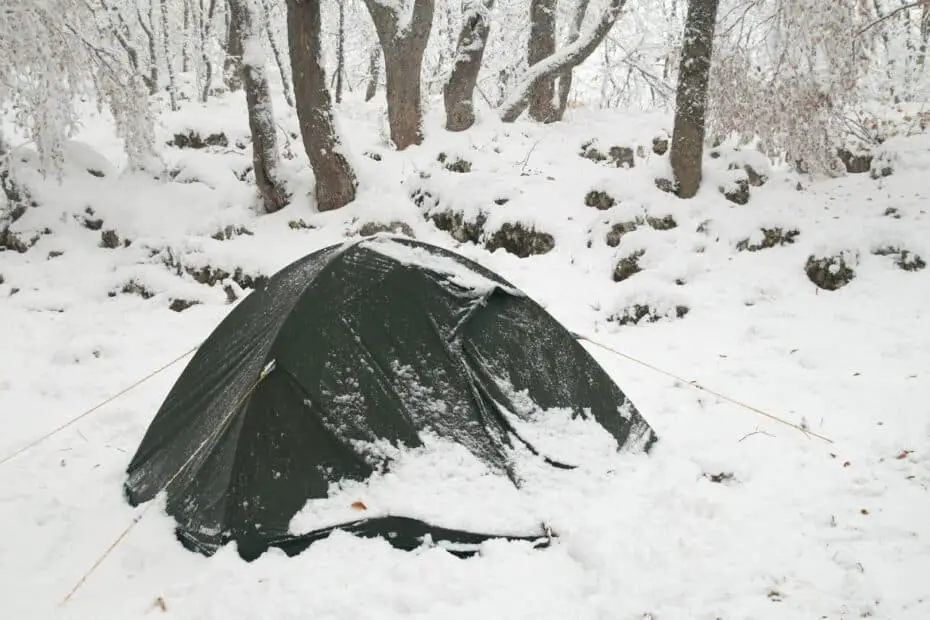Winter is coming, but that doesn’t mean you need to stop camping. With the right tent heater, you can heat a tent in freezing cold weather. While I wouldn’t say it’s better than summer camping, it’s still a fun/unique camping experience. You will still need to rely on your sleep system (sleeping bag and pad) at night, but a tent heater will make your camping experience so much better. So, wow do you heat a tent in cold weather?
There are multiple ways to heat a tent in cold weather. You can use a propane heater (my favorite), wood stove (vented canvas tent), candle lantern, battery powered heater (expensive), or electric heater if there’s power available. Use your external heat source while you’re awake and rely on your sleep system at night.
Don’t get me wrong, I’m not recommending waiting for the next freezing blizzard to go camping. Some days you’re better off staying at home, but you don’t have to be cold with a tent heater and well planned sleep system.
Zero degree sleeping bags, insulated pads, warm layered clothing, and winter tents will help keep you warm at night, but some days you’ll need a little more oomph to keep you comfortable. That’s where tent heaters come in handy. They make hanging out in your tent at night comfortable, but it can be hard to choose between the different ways to heat your tent.
I’ll briefly go over the best ways to heat a tent in the next section, but make sure you keep scrolling down where I explain how to use each method in detail. Most people should go with a propane heater (my favorite), but one of the other choices might be a better fit for your needs.
Table Of Contents
How to Heat A Tent In Cold Weather
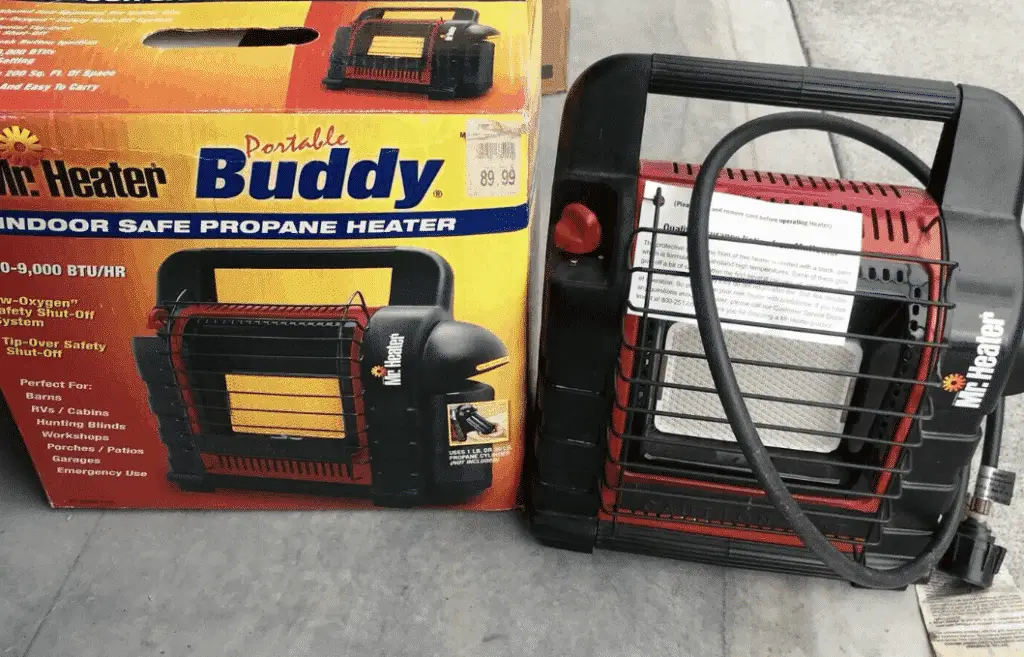
External heat sources all come with a certain degree of danger. However, when the proper precautions are taken they can be used safely.
Start off by working on improving your sleep system than worry about heaters. A quality sleeping bag/pad is all you need to get through the night. With that being said, heaters will help get the chill out of the air. Just don’t expect heat to stay inside thin tent walls.
- Propane Heaters: By far the most popular way to heat a tent. They’re safe to use and you can’t beat the ease of use of propane heaters.
- Wood Burning Heater (Canvas Tent): A wood burning heater paired with a vented canvas tent is the warmest cold weather camping setup.
- Alcohol Camping Heaters: Alcohol camping heaters are one of the only lightweight options for backpackers. It’s a small radiant heater that goes over your ultralight backpacking stove.
- Battery Powered Heaters (extremely expensive): Heaters require a crazy amount of power to run so you will need to spend a small fortune on a portable power station. Here’s an example: pairing a Jackery 1500 (1534 watt capacity) with a Honeywell Cubicle Heater (100 watt/low, 250 watt/high) will get you 6-15 hours of heat. Cheaper power stations won’t have the capacity to run your heater for long.
- Butane Heaters: This is a similar option to propane another, but there’s no clear advantage to using butane over propane. Butane burns slightly hotter, but it’s far more expensive.
- Kerosene Heaters: Kerosene is cheaper and easier to find than propane, but it’s a dirty fuel. You will need to perform regular maintenance on the fuel lines.
- Candle Lanterns (Cheap and Lightweight): Candle lanterns (like this one) are mainly used for light and ambiance, but they will increase the temperature inside your tent by 10°-15°F. A 3-Season tent is 5° warmer so combining the two makes a big difference. You can also heat small amounts of food and water on the heat shield above the flame.
- Electric Heaters (Great For Campgrounds): Electric heaters are safer and easier to use than propane, but running an electric heater isn’t possible in the backcountry. Electric heaters are perfect for campgrounds with electrical hookups (Class A/AA/AAA Sites) or if you’re using a generator. I would go with a cheap 350+ watt cubicle heater since they’re portable, but any electric heater will work (hot without a thermostat).
- Alternative Fuels: If you can think of a fuel, there’s probably a heater that runs off it. I wouldn’t go with any of the alternative fuel heaters, because they usually run on highly flammable fuels that could be dangerous in a tent.
Focus on Your Sleep System Before Heating Your Tent
Heaters should only be used to supplement your sleeping bag and pad. Buy a sleeping bag with a temperature rating 15 degrees lower than the expected night time temperature and high R-Value Sleeping Pad
Sleeping bag liners will add additional versatility to your bag. My Sea to Summit Reactor Liner adds 25 degrees of warmth to my sleeping bags temperature rating. High R-Value sleeping pads will put an extra layer between your body and the cold hard ground.
Once you have your sleep system down you will only need to use the heater while you’re hanging out. Tents are terrible at trapping heat so you will end up burning through lots of fuel if you don’t have access to electricity. Try to use the heater sparingly if you’re limited on fuel.
How To Heat A Tent Without Electricity
Most people won’t have access to electricity while camping in cold weather. That means you will need to heat your tent with either a propane heater or candle lantern. Candle lanterns are more for light than heat, but they will increase the temperature in your tent by 10°-15° Fahrenheit.
Wood burning heaters and pellet heaters can also be used, but they need a canvas tent with an exhaust vent. You don’t have to spend a lot on a wood burning stove. It won’t be pretty, but a cheap portable military camping stove will put out more than enough heat. Winnerwell stoves are top of the line if that fits your budget, and there are plenty of mid range stoves in the $100-$200 price range (check them out).
I will ignore battery powered setups in this category since 99% of people (probably more) won’t be able to afford a high capacity portable power station and solar setup. It can work, but you would need to spend $2000-$3000 on a battery powered tent heater setup. I’ll talk about them a little bit below, but you may want to check out my post on heating a tent with a battery powered heater for more info.
1. Propane Heaters Are The Best Way To Heat Your Tent In Mild Weather Without Electricity
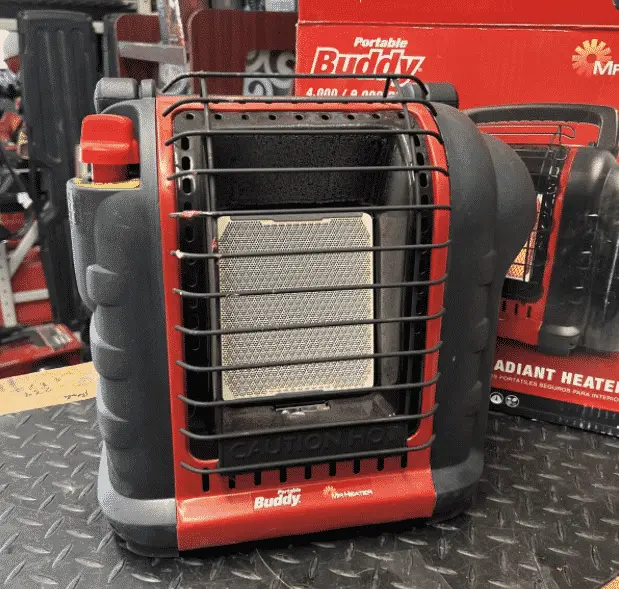
Propane heaters are by far the best option when cold weather camping. They’re highly efficient, portable, and very easy to use. The only downside is they don’t put off enough heat in extremely cold temperatures. They’re awesome on 25+ degree nights, but struggle to keep up at lower temperatures. I use the little buddy heater, but you can always get the Big Buddy to double the heat output.
Check out my post where I teach you how to safely use a propane tent heater for more info.
Propane camping heaters run off of 1lb disposable propane tanks, but you can use a 1lb to 20lb propane tank adapter if you need it for longer than 8 hours. A 20lb propane tank will run power a Buddy Heater for 160 hours on low, 80 hours on medium, and 40 hours on high.
Mr Heater is by far the most popular propane camping heater on the market. I’ve been camping with my buddy heater for as long as I can remember. I’m still using the same Mr Heater Little Buddy that I got for Christmas as a cub scout in elementary school.
Propane heaters will emit trace amounts of carbon monoxide, but it’s well below the safety threshold. This shouldn’t be a problem since tents are well ventilated, but it’s worth mentioning. Breathing in trace amounts of carbon monoxide isn’t a big deal, but you wouldn’t want to use a propane heater in a winter/mountaineering tent.
Why I Prefer Propane Tent Heaters
- Warmth At An Affordable Price: Propane Heaters are by far the most affordable option for heating a tent. A typical propane heaters costs less than $100 and heats over 225 square feet of tent space (that’s a big tent).
- Highly Efficient Catalytic Burner: Catalytic burns are safe to use and highly efficient. They run just under the complete combustion line so you’ll get hours of heat on a single 1lb tank and there’s minimal risk of carbon monoxide and fire.
- Built In Safety Features: All propane camping heaters are designed with built in safety features. They have tip over protection, enclosed heating elements, and carbon monoxide detectors. Trace amounts of carbon monoxide gets released into the air, but it will quickly make its way out of the tent.
- Lightweight and Portable: Propane camping heaters are designed with transportation in mind. They have lightweight bodies, built in handles, and run off 1lb disposable propane tanks. They’re far too heavy for backpacking, but they’re perfect for primitive campgrounds.
- Runs For Hours On A Single Tank: You can run a Mr Heater Buddy Heater for 8 hours on low with a single disposable 1lb propane tank. Tents are tiny so that will be more than enough heat (maybe too much).
2. Wood Burning Stoves Are A Great Way To Heat Canvas Tents With Exhaust Ports
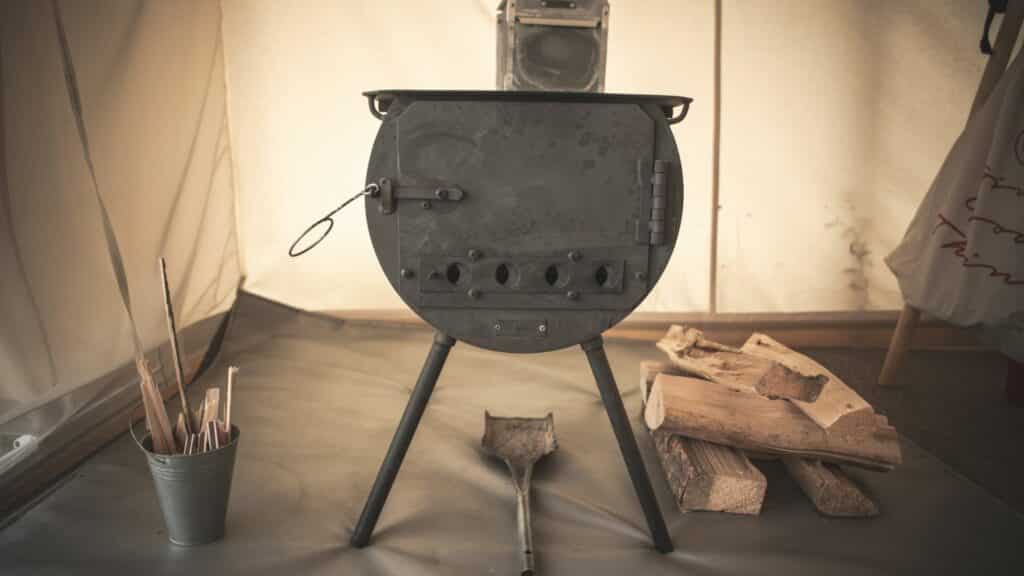
Canvas tents that are heated by a wood burning stove are extremely popular in the hunting community, but campers/backpackers rarely use them. Wood burning stoves are a great way to heat a canvas tent, but they won’t work with a typical synthetic camping tent.
You really can’t beat the heat of a wood burning stove when it’s paired with a canvas tent. There’s an endless fuel supply of wood to heat your tent up as hot as you want. Plus canvas tents have way more insulation than synthetic tents and they’re designed to trap heat. That’s sounds great on paper, but it will lead to condensation issues on the walls of your tent.
When you’re shopping for a canvas tent make sure it has a stove jack. The stove jack is basically just a waterproof flap that opens up so you can run your stoves flue (exhaust pipe) outside. Canvas material is easy to work with so you can cut/sew in vent flap, but it’s nice to have one built into your tent.
Using a wood burning stove with a canvas tent is by far the warmest way to heat a tent, but there are three major problems with this setup. Canvas tents and wood burning stoves are heavier than the other options. It’s much harder to setup a canvas tent, put together the fireplace, run a vent pipe, and build a fire in the stove. The entire setup will cost a minimum of $500, but it’s usually well into the $1000+ range.
There are a wide range of canvas tents that can be used with stoves so I can’t list them all, but I will give you a few suggestions on choosing a wood burning heater for your tent. They all work in a similar manner, but you will need to choose between lightweight/folding models and bulky cheaper stoves.
Winnerwell makes some of the best wood burning stoves on the market. They’re lightweight and fold down into a compact package for easy transport/storage. It would be the perfect stove if it wasn’t for the price.
I recommend looking at the lineup of Winnerwell stoves and finding a similar model that copies their designs. That might sound callous, but you can save a lot of money by choosing a budget model. It’s a stainless steel folding box with a pipe sticking out the top. They shouldn’t be that expensive!
3. Alcohol Camping Heaters
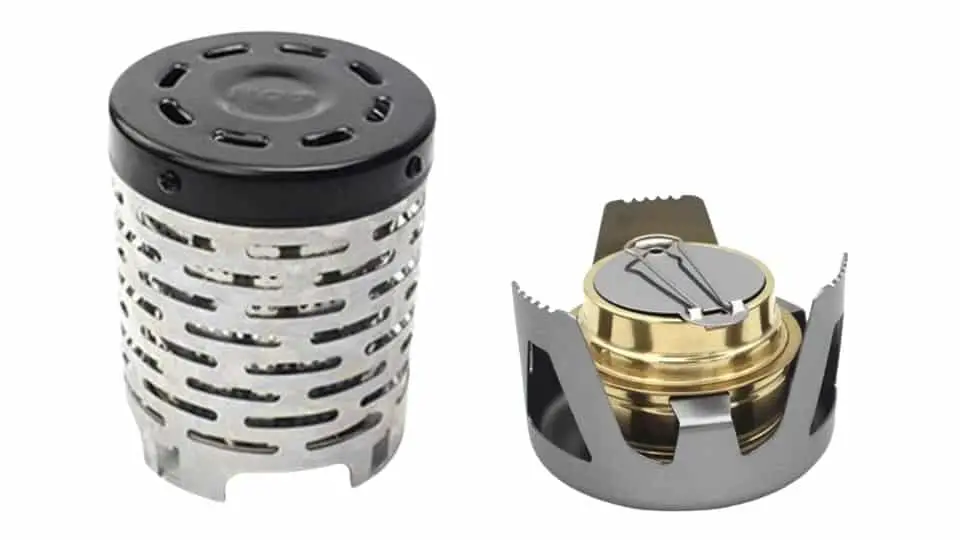
Alcohol camping heaters are by far the lightest option on this list. It’s basically the only option when you’re backpacking and need to keep your pack weight down. Thankfully even the most expensive alcohol heaters are ridiculously cheap and they put out a surprising amount of heat (similar to propane).
When you look at the design of an alcohol camping heater you why they’re so affordable. It’s basically just an upside down coffee can with a bunch of holes drilled out that sits on an alcohol stove. You can easily make your own, just by looking at the design.
I used a homemade alcohol stove/heater for years, but I eventually forked over $20 to switch over to a fancy version. Maybe I’m biased, but the real heater seems like it gets hotter than my coffee can setup. It was just a cheap generic heater that I found on Amazon (similar to this one) that goes over an alcohol stove (like this), filled with denatured alcohol.
When I first bought an alcohol heater I was worried about catching everything on fire. After accidentally knocking over the heater I realized that’s not a problem. The flame self-extinguishes when you knock it over. After freaking out for a second I tested it a few more times and the flame always goes out.
4. Battery Powered Tent Heaters
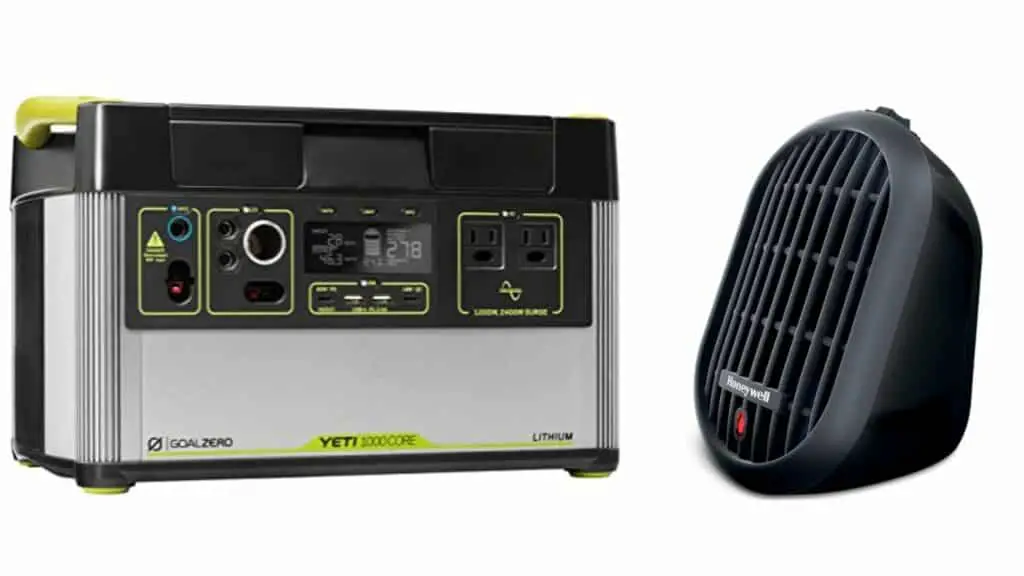
Unfortunately, there’s no dedicated battery powered camping heater, but there is a way to power a low wattage heater with battery power. You would need to purchase a high capacity portable power station and use it with a low wattage heater like a cubicle heater.
Check out my post where I explain battery powered tent heaters in detail for more info.
The only downside to battery powered heaters is the price and battery life. Plan on spending a small fortune on a high capacity portable power station (like this one). Pair your portable power station with a small 300 watt cubicle heater. The Honeywell Cubicle heater is a perfect choice since it has a 300 Watt and 100 Watt mode.
You can get 3-4 hours of heat on the high setting (10 hours low) with a portable power station like the Goal Zero Yeti 1000 (983 wH). Jackery Power Stations are another great choice with a wide range of high capacity batteries and solar setups.
Look for power stations with 1000-2000 wH batteries, but plan on spending a small fortune with this kind of setup. That seems to be the sweet spot for capacity and price. Once you get into the 2000+ wH range portable power stations get far more expensive.
A short 3-4 hour battery life isn’t a big deal since most people shut off their heater while they’re sleeping. The heater is used for supplemental heat while you’re hanging around in the tent, but you shouldn’t rely on a heater to run at night. Buy a sleeping bag that’s 15° warmer than expected nighttime temps and high R-Value sleeping pad just in case the heater quits working.
5. Butane Tent Heaters Are Similar To Propane, But There Are Problems
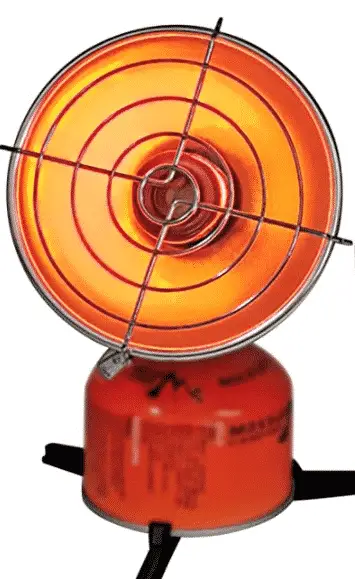
Propane is by far the king of clean burning camping heaters, but butane heaters aren’t far behind. I can see why it’s popular, but there aren’t many reasons why butane would be better option than propane.
The only advantage is butane heaters tend to be a little bit smaller and cheaper than propane heaters making them perfect for backpacking. Check out the Taruor Butane Heater (pictured above). It’s an affordable no frills heater that’s perfect for a cold weather backpacking setup.
Butane heaters are very similar to propane. They give off a similar amount of heat, burn clean, and you probably wouldn’t be able to tell the difference in a side by side comparison. With that being said there are a handful of problems when using butane.
The bottles are more expensive, it’s hard to find in remote areas, and you’ll have a hard time lighting the heater in freezing cold temperatures. Most propane heaters can be converted to butane if you really want to try it out.
6. Kerosene Heaters Are A Dirty Smelly Heat Source
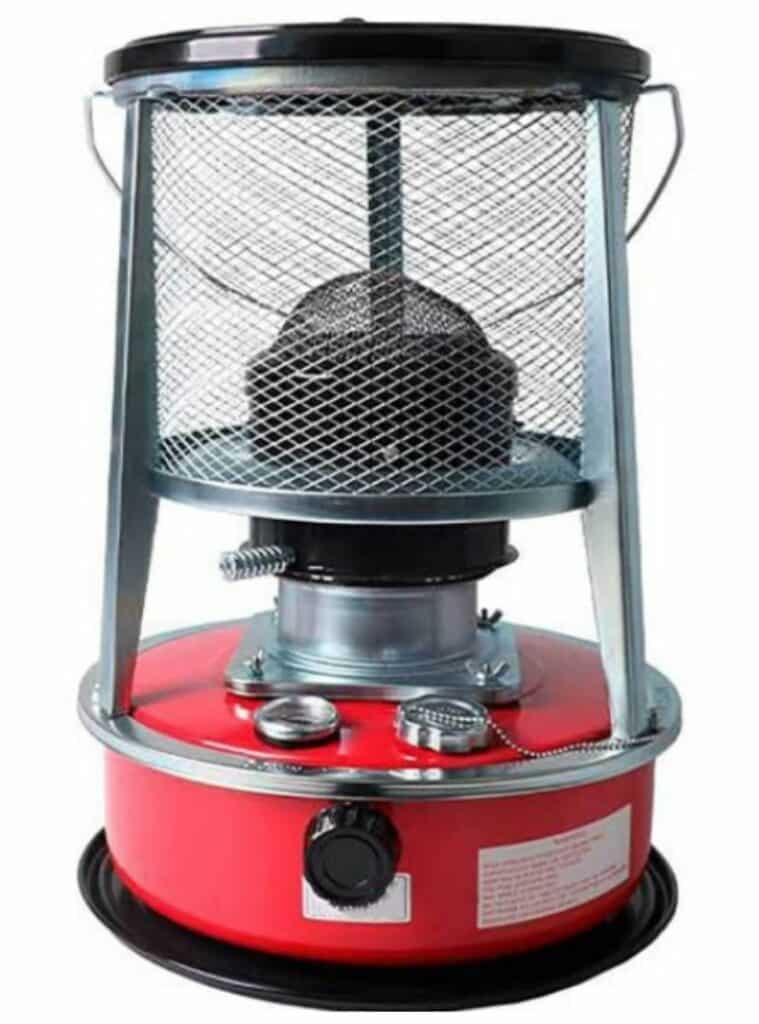
Kerosene heaters provide similar heat output to propane, but it’s a dirty and smelly fuel source. All your gear will be covered in a kerosene stench that’s hard to get out. Plus they’re unreliable and tend to be expensive.
A kerosene camping heater will work great for a while, but it’s a dirty fuel so it will clog up your fuel lines at the worst possible time. Get a bad batch of kerosene or neglect the fuel lines and you’re screwed. Propane heaters can clog up as well, but I’ve never had it happen.
The only time kerosene heaters make sense is when you’re traveling to a foreign country for a remote backpacking trip. It can be hard to find propane/butane tanks, but you can buy kerosene anywhere. Kerosene is a cheap fuel that’s used for cooking throughout the world. So it doesn’t matter where you are, there will be a kerosene supplier somewhere.
Save yourself the hassle and use a propane heater. There’s no functional advantage to using kerosene and you won’t have the option of hooking up a 5lb, 10lb, or 20lb propane tank if you need to run the heater for a ridiculously long time.
7. Candle Lanterns Are A Cheap And Portable Way To Heat Your Tent
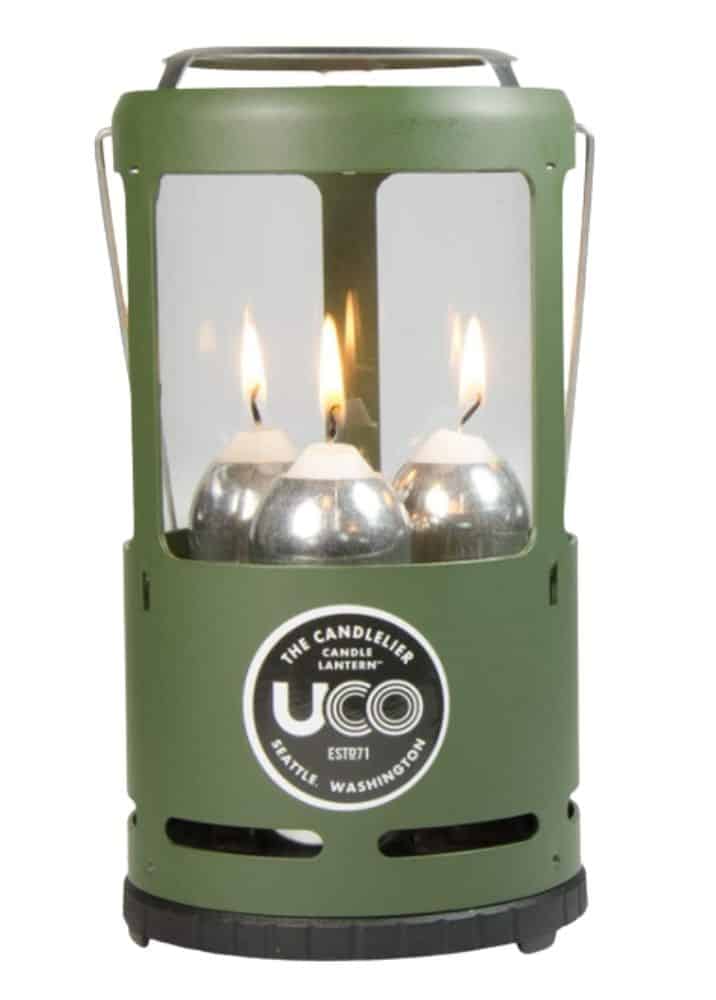
I have a crazy obsession with candle heaters. My mom bought one to set next to her patio chairs a few years ago and I fell in love. They’re lightweight/portable, cheap, provide light/ambiance, can heat up food, and increase the temperature inside your tent by about 15°F.
Candle lanterns are perfect for mild weather when you need a little bit more heat to stay comfortable. You can be comfortable wearing a t-shirt in your tent in 50° weather. Set a 9 hour lantern candle on the spring-loaded candle holder, light it up and you’re good to go.
I use the UCO Candlelier Deluxe Candle Lantern and I really like it. The candles are about $1 each so burning through them isn’t that big of a deal. Light it at dusk and let it burn until you go to bed since the candles last 9 hours. Just don’t get the single candle version, because it won’t put off much heat.
8. Electric Space Heaters That You Use At Home
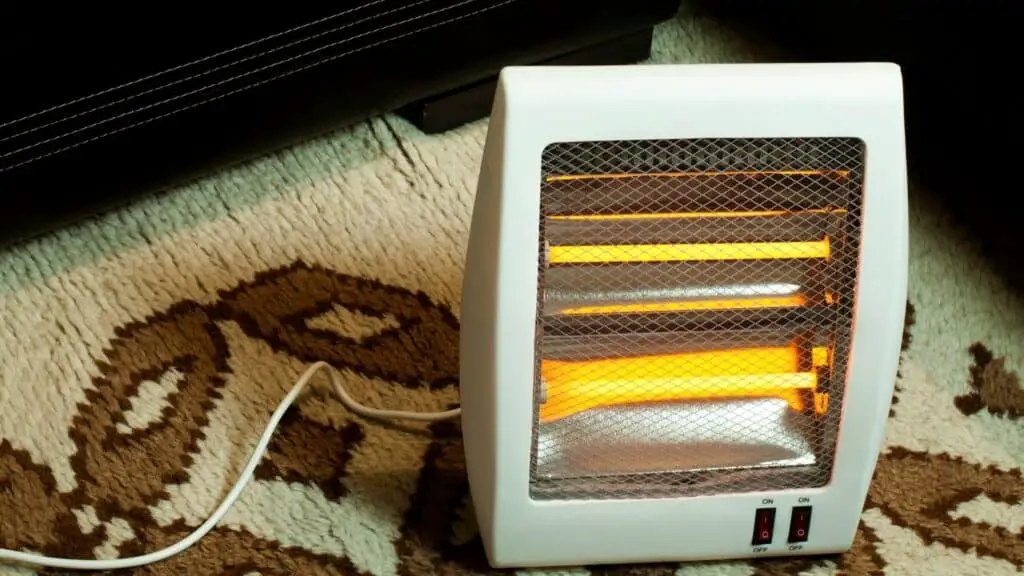
You can use any electric space heater in your tent if there’s a reliable power source. Most campgrounds offer combination of primitive sites and more expensive sites with electrical access. Any Class A, Class AA, Class AAA campsite will have electrical service. The only sites that don’t have electric are Class B and primitive campsites.
Personally, I wouldn’t use a gas or diesel powered generator to run an electric heater in my tent. Most generators are crazy loud so it will be hard to sleep right next to it. Plus most campgrounds ban generators after 10pm or whenever quiet hours start.
Electric space heaters are too strong for the battery capacity of portable power stations at this point. So you won’t be able to use them with that kind of setup.
9. Alternative Fuel Tent Heaters Can Be Extremely Dangerous
Propane, kerosene, and butane are by far the most popular fuels used in camping heaters, but there are a wide variety of options. If there’s a way to light something on fire, you can probably find a heater utilizing it as a fuel source.
Whether or not these fuels are safe to use is an entirely different question. Old school US Military Camping Stoves could run on diesel, gasoline, and oil. You can immediately see the problem with using those fuels as a heat source.
They’re highly flammable, inefficient, and release carbon monoxide into the air. I shouldn’t have to explain how dangerous it is to use a camping stove that runs off of a highly flammable liquid. One small mistake could light you and your gear on fire. It’s not worth the risk when there are safer options available.
Does It Matter What Kind Of Tent I Use With A Heater?
Before I start explaining how to heat a tent, lets ask a simple question. Is it warmer inside a tent? Yes it will be slightly warmer, but tents aren’t designed to trap heat. They’re actually designed to increase air circulation to cut down on condensation.
A typical 3-Season tent will be 5°F warmer than the outside air. It will feel warmer than that without wind, but it won’t make a huge difference in temperature. Winter tents are a little better at 10°-15°F and mountaineering tents can be 25°F warmer, but they’re prohibitively expensive.
That makes it seem like it would be better to use a winter/mountaineering tent with your heater, but that causes a major problem. I can guarantee you will end up with a crazy amount of condensation in a cold weather tent.
Winter tents are designed to cut off ventilation so there will be a huge temperature difference between the inside and outside air. Pair that with the excess moisture from snow and you have a recipe for condensation.
Go with a high quality 3-Season tent with aluminum poles and make sure you brush off snow when it starts to pile up. Your tent should be able to handle 3-4 inches of snow and the curved design will shed most of the snow down the sides.
